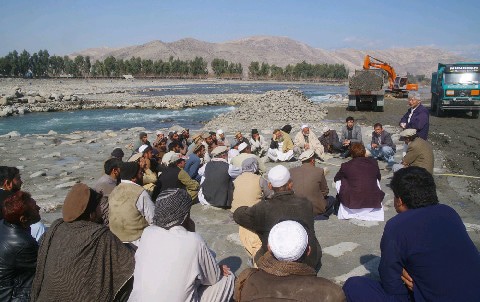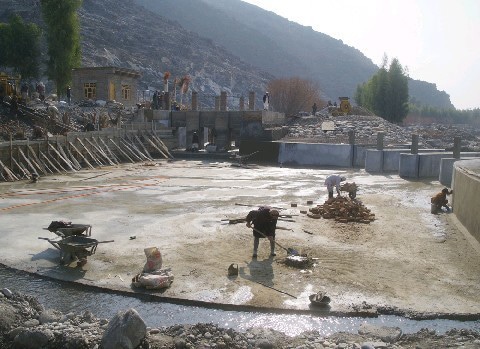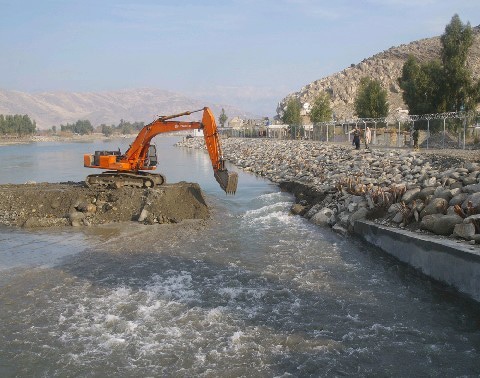【In the Land of the Afghans – Reports from Dr. Tetsu Nakamura】The ingenious Yamada Weir breakthrough
Published on April 1, 2019 - The Nishinippon Newspaper
In winter, the Kunar River’s flow is clear. Its blue waters reflect the sky and its torrents rise in pure white splashing rapids. At an altitude of more than 7,000 meters, the Hindu Kush range is the source of this river which has the largest volume of water in Afghanistan. After 16 years of work, the long-cherished wish for the river has finally been accomplished. This means the technical completion of bringing the Yamada Weir model from Japan to Afghanistan. The spectacle of the clear waters of the great river flowing over the weir across a single giant stone plate is impressive. Everyone who passes by stops in silence and is drawn into its mysterious world.
■Traditional techniques from Japan’s Edo Period
The Yamada Weir, located in Asakura City, Fukuoka Prefecture is a stone- pitched oblique weir (a type of weir in which stones are diagonally arranged) built more than two hundred years ago. It is believed that these types of weirs were built in hundreds of locations across Japan during the Edo period, which helped to cultivate farmland in plains that had been affected by flooding. These original weirs have since disappeared after being replaced by more modern intake weirs. The Yamada Weir is the only one that remains in its original form and is still in use. The imposing stone weir crossing the entire river is overwhelmingly impressive, and it has a stable water intake function that is skillfully adapted to the river's topography. Tremendous effort has gone into making this stone-pitched oblique design an appropriate technology for the mountainous regions of Afghanistan.
The current situation in Afghanistan is often described in terms of political issues, such as civil war and Islamic extremists, but what plagues the people the most is water shortages caused by climate change. It is not well known that in a country where most of the population lives on agriculture, frequent droughts and progressive desertification throughout the country have wreaked fatal havoc. In 2000, after witnessing the catastrophic drought, the PMS (Peace Japan Medical Services) took on the reconstruction of a devastated village and pursued a regional irrigation plan.
Since the start of the project, we didn’t know what solutions might exist besides water intake from the huge Kunar River. However, while the river was drying in autumn, in the summer, it was rampaging out of control and flooding occurred frequently due to the snowmelt at a much faster pace than before, because of the rise in temperatures. Hit both by drought and flooding, more and more villages were abandoned even along the riverside, not just the villages far away from the river.
In addition, electrical power was not available in the mountainous areas, and obtaining equipment and materials was difficult. Furthermore, the Afghan village people’s inclination for independence and the deterioration of security due to the civil conflict has made public works like those found in Japan exceedingly difficult in terms of both technology and finance.
■Quest for stable water intake
As we considered possibilities for creating a stable water intake mechanism, the concept of the Yamada Weir grew. The low-cost model in combination with the simple equipment and a structure, which the locals could maintain made it our best option. The challenge we faced was that there was no precedent, but we decided to take it on, in anticipation of conducting research and construction simultaneously.
Although by 2016, nine weirs and over 35 kilometers of main canals were built, creating stable irrigation for 16,000 hectares of land with 600,000 people, we could not hand over the system or even withdraw from the difficult and complicated construction until the stable water intake was achieved; hence setting the maximum goal as “Technical completion of intake weir."
This PMS method, a whole set of oblique weirs and other accompanying water intake structures, was first systematically introduced at the Kama Weir. This river basin embraces 7,000 hectares of agricultural land with a population of 300,000 people, representing one of the largest tracts of farmland in eastern Afghanistan. At the start of construction, the devastation in the area caused by drought was remarkable, with most of the local resident populations having fled as refugees. In the past, the former Soviet Union, Arab and American proxy groups and others, had considered options to create a stable water intake in this area, but all parties had concluded that the torrential flow of the Kunar River made it impossible to build a weir.
Starting in 2010, PMS began the impossible - a two-year construction of the weir and the restoration of the existing irrigation canal. Although most of the former residents had returned home, the construction of the weir was still in progress. Over the course of 15 years, the weir was built and collapsed, then improved and re-built over and over again, as if it was a never-ending process. We approached this project as a hydraulic model experiment; observing the performance of the weir, ultimately aiming for perfection.
Using the knowledge we had gained over the course of our experiments, it was only last year that we were finally able to confidently hand over the project to the locals. We gradually came to understand the movement of the Kunar River, which allowed us to improve construction techniques that overcame structural weaknesses, leading to the development of a new standard design.
■Government steps up cooperation
In February 2019, the construction of the Kama Weir was successfully completed after eight years of work, and the beautiful stone-pitched weir gave people a sense of relief. With this success, momentum has increased. Amid the possibility of new droughts, the Government of Afghanistan has taken the initiative to declare the design of our weir construction method a national standard and has begun, working with international organizations, sending engineers to the PMS training center for disseminating the PMS method across the country.
Cooperation from the Japanese side supported our persistence. The close to 3-billion yen in individual donations toward the project is not just a sum, but a symbol of the hundreds of thousands of Japanese consciences that stepped up in support. This project represents more than just a technological success. Nineteen years after the major drought of 2000, in the face of a rapidly changing world, empathy and cooperation may be at the heart of what we can learn from our predecessors who built the Yamada Weir.
× ×
This is a translation of a report from Afghanistan by Dr. Tetsu Nakamura, a Japanese medical doctor who was gunned down on December 4, 2019 in Afghanistan at the age of 73. Dr. Nakamura was the head of the international NGO, Peace Japan Medical Services (PMS). In addition to medical services, PMS provides various forms of assistance to local communities in Afghanistan’s eastern Nangarhar province, including the construction of irrigation systems, related agricultural programming and provision of food support. PMS is funded by Peshawar-kai, which was established in 1983 to collect donations from people and support the project implementation of Dr. Nakamura and his team.
This report is one of 27 installments in the series “In the Land of the Afghans – Reports from Dr. Tetsu Nakamura,” which ran from May 25, 2009 to December 2, 2019. They were originally published by the local newspaper in Dr. Nakamura’s hometown in Fukuoka, Japan. The text has been translated from Japanese to English, with the support of Peshawar-kai, by more than 30 volunteers, many of whom work in the field of humanitarian and development aid, and who have been and will continue to be inspired by Dr. Nakamura's work and philosophy.






